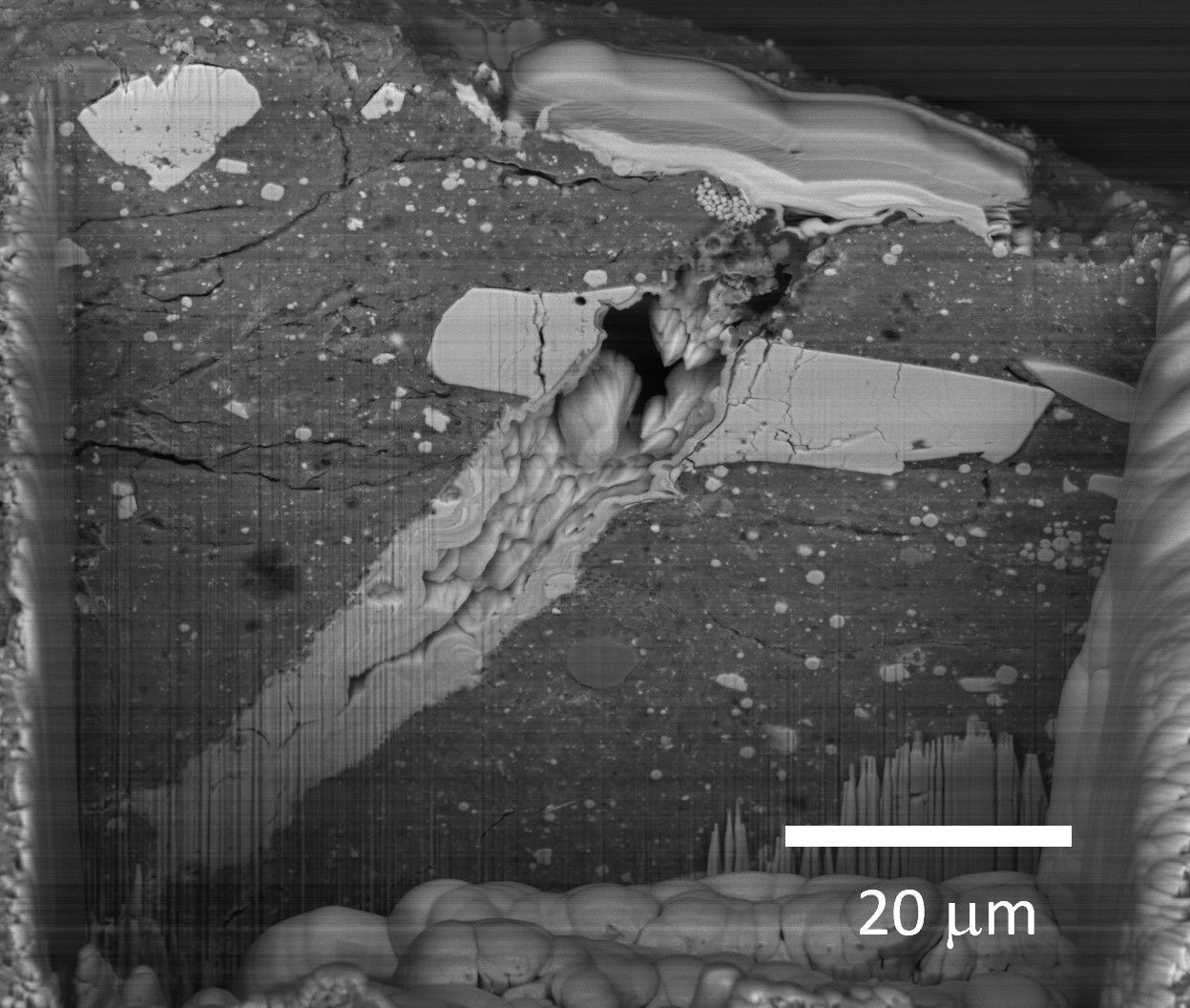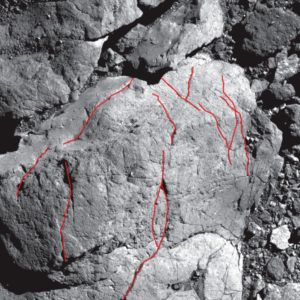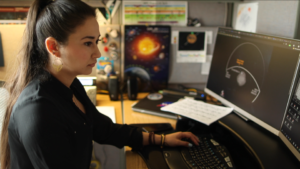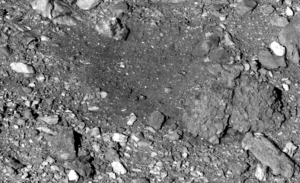
A scanning electron microscope image of a micrometeorite impact crater in a particle of asteroid Bennu material.
Credits: NASA/Zia Rahman
Asteroid Bennu, sampled by NASA’s OSIRIS-REx mission in 2020, is a mixture of dust that formed in our solar system, organic matter from interstellar space, and pre-solar system stardust. Its unique and varied contents were dramatically transformed over time by interactions with water and exposure to the harsh space environment.
These insights come from a trio of newly published papers based on the analysis of Bennu samples by scientists at NASA and other institutions.
Bennu is made of fragments from a larger parent asteroid destroyed by a collision in the asteroid belt, between the orbits of Mars and Jupiter. One of the papers, co-led by Jessica Barnes at the University of Arizona, Tucson, and Ann Nguyen of NASA’s Johnson Space Center in Houston and published in the journal Nature Astronomy, suggests that Bennu’s ancestor was made up of material that had diverse origins—near the Sun, far from the Sun, and even beyond our solar system.
The analyses show that some of the materials in the parent asteroid, despite very low odds, escaped various chemical processes driven by heat and water and even survived the extremely energetic collision that broke it apart and formed Bennu.
“We traced the origins of these initial materials accumulated by Bennu’s ancestor,” said Nguyen. “We found stardust grains with compositions that predate the solar system, organic matter that likely formed in interstellar space, and high temperature minerals that formed closer to the Sun. All of these constituents were transported great distances to the region that Bennu’s parent asteroid formed.”
The chemical and atomic similarities of samples from Bennu, the asteroid Ryugu (sampled by JAXA’s (the Japan Aerospace Exploration Agency) Hayabusa2 mission) and the most chemically primitive meteorites collected on Earth suggest their parent asteroids may have formed in a similar, distant region of the early solar system. Yet the differences from Ryugu and meteorites that were seen in the Bennu samples may indicate that this region changed over time or did not mix as well as some scientists have thought.
Though some original constituents survived, most of Bennu’s materials were transformed by reactions with water, as reported in the paper co-led by Tom Zega of the University of Arizona and Tim McCoy of the Smithsonian’s National Museum of Natural History in Washington and published in Nature Geoscience. In fact, minerals in the parent asteroid likely formed, dissolved, and reformed over time.
“Bennu’s parent asteroid accumulated ice and dust. Eventually that ice melted, and the resulting liquid reacted with the dust to form what we see today, a sample that is 80% minerals that contain water,” said Zega. “We think the parent asteroid accumulated a lot of icy material from the outer solar system, and then all it needed was a little bit of heat to melt the ice and cause liquids to react with solids.”
Bennu’s transformation did not end there. The third paper, co-led by Lindsay Keller at NASA Johnson and Michelle Thompson of Purdue University, also published in Nature Geoscience, found microscopic craters and tiny splashes of once-molten rock – known as impact melts – on the sample surfaces, signs that the asteroid was bombarded by micrometeorites. These impacts, together with the effects of solar wind, are known as space weathering and occurred because Bennu has no atmosphere to protect it.
“The surface weathering at Bennu is happening a lot faster than conventional wisdom would have it, and the impact melt mechanism appears to dominate, contrary to what we originally thought,” said Keller. “Space weathering is an important process that affects all asteroids, and with returned samples, we can tease out the properties controlling it and use that data and extrapolate it to explain the surface and evolution of asteroid bodies that we haven’t visited.”
As the leftover materials from planetary formation 4.5 billion years ago, asteroids provide a record of the solar system’s history. But as Zega noted, we’re seeing that some of these remnants differ from what has been found in meteorites on Earth, because certain types of asteroids burn up in the atmosphere and never make it to the ground. That, the researchers point out, is why collecting actual samples is so important.
“The samples are really crucial for this work,” Barnes said. “We could only get the answers we got because of the samples. It’s super exciting that we’re finally able to see these things about an asteroid that we’ve been dreaming of going to for so long.”
The next samples NASA expects to help unravel our solar system’s story will be Moon rocks returned by the Artemis III astronauts.
Melissa Gaskill
Johnson Space Center








































































